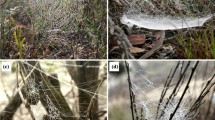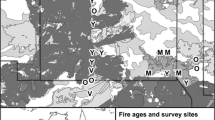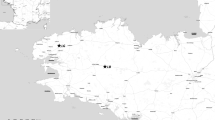Abstract
Fire is a natural feature of many ecosystems, with some vegetation types highly adapted to fire. However, very little is known about the effect of fire on spiders, especially as fires have become more frequent owing to human activity. We determine whether different spider functional guilds (web builders vs. wanderers) respond differently to fires in the sclerophyllous fynbos. We determine also the effect of rockiness as refuge for these guilds and whether it influences their post-fire recovery. There were three site categories of time-since-last fire: 3 months, 1 year, and 7 years. We found that fire caused a decline in spider richness and abundance, with the 3-month category supporting the lowest. In sites that were burned within 1 year, abundance of wanderers was as high as in sites that had 7 years to recover, whereas species richness and abundance of web builders in sites that were burned 1 year ago were as low as in recently burned sites. However, assemblages of wanderers differed among categories, while no differences were observed for web builders, highlighting that wanderers took longer time to recover than web builders. Species richness and abundance of both guilds were not affected by different levels of rockiness. However, rockiness is important in shaping assemblages of wanderers. The results emphasize that the assemblages of greatest conservation concern with increased fire frequencies are wanderers and are candidate surrogates for monitoring post-fire recovery. These results highlight the need to allow fynbos vegetation to recover fully between fire intervals and draws attention to the dangers of frequent unplanned fires.





Similar content being viewed by others
References
Anderson MJ (2006) Distance-based tests for homogeneity of multivariate dispersions. Biometrics 62:245–253. https://doi.org/10.1111/j.1541-0420.2005.00440.x
Anderson MJ, Willis TJ (2003) Canonical analysis of principal coordinates: a useful method of constrained ordination for ecology. Ecol 84:511–525
Bates D (2005) Fitting linear mixed models in R. R News 5:27–30
Brandt Y, Lubin Y (1998) An experimental manipulation of vegetation structure: consequences for desert spiders. Isr J Zool 44:201–216
Braschler B, Chown SL, Gaston KJ (2012) The fynbos and succulent karoo biomes do not have exceptional local ant richness. PLoS ONE 7:1–9. https://doi.org/10.1371/journal.pone.0031463
Cera I, Spuņģis V (2011) Seasonal activity of wolf spiders (Araneae: Lycosidae) in coastal dune habitats at Akmensrags-Ziemupe Nature Reserve, Latvia. Environ Exper Biol 9:91–97
Chai YQ, Wilgers DJ (2015) Effects of temperature and light levels on refuge use and activity in the wolf spider. Trans Kansas Acad Sci 118(3–4):194–200
Cowling RM (1992) The ecology of fynbos: nutrients, fire and diversity. Oxford University Press, Cape Town
Crous CJ, Samways MJ, Pryke JS (2013) Exploring the mesofilter as a novel operational scale in conservation planning. J Appl Ecol 50:205–214. https://doi.org/10.1111/1365-2664.12012
de Cáceres M, Legendre P (2009) Associations between species and groups of sites: indices and statistical inference. Ecol 90:3566–3574
Dippenaar-Schoeman AS (2014) Field guide to the spiders of South Africa. LAPA Publishers, Pretoria
Dippenaar-Schoeman AS, Leroy A (2003) A checklist of the spiders of the Kruger National Park, South Africa, South Africa (Arachnida: Araneae). Koedoe 46:91–100. https://doi.org/10.4102/koedoe.v46i1.40
Dippenaar-Schoeman AS, Van den Berg MV, Van den Berg AM, Van den Berg A (2001) Spiders in macadamia orchards in the Mpumalanga Lowveld of South Africa: species diversity and abundance (Arachnida: Araneae). Afr Plant Prot 7:39–46
Dippenaar-Schoeman AS, Van den Berg AM, Van den Berg MA, Foord SH (2005) Spiders in avocado orchards in the Mpumalanga Lowveld of South Africa: species diversity and abundance (Arachnida: Araneae). Afr Plant Prot 11:8–16
Fasola M, Mogavero F (1995) Structure and habitat use in a web-building spider community in northern Italy. Ital J Zool 62:159–166. https://doi.org/10.1080/11250009509356064
Foord SH, Dippenaar-Schoeman AS, Haddad CR, Lotz LN, Lyle R (2011) The faunistic diversity of spiders (Arachnida: Araneae) of the savanna biome in South Africa. Trans R Soc S Afr 66:170–201. https://doi.org/10.1080/0035919X.2011.639406
Foord SH, Dippenaar-Schoeman AS, Jocqué R, Haddad CR, Lyle R, Webb P (2016) South African National Survay of Arachnida: a checklist of spiders (Arachnida, Araneae) of the Lekgalameetse Nature Reserve, Limpopo province, South Africa. Koedoe 58:1–8. https://doi.org/10.4102/koedoe.v58i1.1405-1
Foster CN, Barton PS, Wood JT, Lindenmayer DB (2015) Interactive effects of fire and large herbivores on web-building spiders. Oecologia 179:237–248. https://doi.org/10.1007/s00442-015-3323-5
Hore U, Uniyal VP (2008) Effect of prescribed fire on spider assemblage in Terai grasslands India. Turk J Arch 1:15–36
Hothorn T, Bretz F, Westfall P (2008) Simultaneous inference in general parametric models. Biom J 50:346–363
Hugo-Coetzee EA, Avenant NL (2011) The effect of fire on soil oribatid mites (Acari: Oribatida) in a South African grassland. Zoosymposia 6:210–220
Hunter ML Jr (2005) A mesofilter conservation strategy to complement fine and coarse filters. Conserv Biol 19:1025–1029
Joubert L, Pryke JS, Samways MJ (2014) Annual burning drives plant communities in remnant grassland ecological networks in an afforested landscape. S Afr J Bot 92:126–133. https://doi.org/10.1016/j.sajb.2014.02.009
Kraaij T, Cowling RM, Van Wilgen BW (2013) Fire regimes in eastern coastal fynbos: imperatives and thresholds in managing for diversity. Koedoe 55:1–9. https://doi.org/10.4102/koedoe.v55i1.1104
Kwon TS, Park YK, Lim JH, Ryou SH, Lee CM (2013) Change of arthropod abundance in burned forests: different patterns according to functional guilds. J Asia Pac Entomol 16:322–328. https://doi.org/10.1016/j.aspen.2013.04.008
Lapinski W, Tschapka M (2013) Habitat use in an assemblage of Central American wandering spiders. J Arachn 41:151–159. https://doi.org/10.1636/P11-88.1
Melliger RL, Braschler B, Rusterholz HP, Baur B (2018) Diverse effects of degree of urbanisation and forest size on species richness and functional diversity of plants and ground surface-active ants and spiders. PLoS ONE 13:15. https://doi.org/10.1371/journal.pone.0199245
Moretti M (2002) Effects of winter fire on spiders. Eur Arachn 2000:183–190
Mucina L, Rutherford MC (2011) The vegetation of South Africa, Lesotho and Swaziland. Strelitzia 19. South African National Biodiversity Institute, Pretoria
New TR (2014) Insects, fire and conservation. Springer, London
Parr CL, Robertson HG, Biggs HC, Chown SL (2004) Response of African savanna ants to long-term fire regimes. J Appl Ecol 41:630–642. https://doi.org/10.1111/j.0021-8901.2004.00920.x
Podgaiski LR, Joner F, Lavorel S, Moretti M, Ibanez S, Mendonc MS, Pillar VD Jr (2013) Spider trait assembly patterns and resilience under fire-induced vegetation change in South Brazilian grasslands. PLoS ONE 8:1–11. https://doi.org/10.1371/journal.pone.0060207
Proçhes S, Cowling RM (2006) Insect diversity in Cape fynbos and neighbouring South African vegetation. Global Ecol Biogeogr 15:445–451. https://doi.org/10.1111/j.1466-822X.2006.00239.x
Pryke JS, Samways MJ (2010) Significant variables for the conservation of mountain invertebrates. J Insect Conserv 14:247–256. https://doi.org/10.1007/s10841-009-9253-y
Pryke JS, Samways MJ (2012a) Importance of using many taxa and having adequate controls for monitoring impacts of fire for arthropod conservation. J Insect Conserv 16:177–185. https://doi.org/10.1007/s10841-011-9404-9
Pryke JS, Samways MJ (2012b) Differential resilience of invertebrates to fire. Austral Ecol 37:460–469. https://doi.org/10.1111/j.1442-9993.2011.02307.x
Richardson DM, Van Wilgen BW (1992) Ecosystem, community and species response to fire in mountain fynbos: conclusions from the Swartboskloof experiment. In: Van Wilgen BM, Richardson DM, Kruger FJ, Van Hensbergen HJ (eds) Fire in South African Mountain Fynbos. Ecol Stud 93: 273 − 314
Sasal Y, Raffaele E, Farji-Brener AG (2015) Consequences of fire of and cattle browsing on ground beetle (Coleoptera) in NW Patagonia. Ecol Res 30:1015–1023. https://doi.org/10.1007/s11284-015-1302-2
Stewart AJ, Wright AF (1995) A new inexpensive suction apparatus for sampling arthropods in grassland. Ecol Entomol 20:98–102. https://doi.org/10.1111/j.1365-2311.1995.tb00434.x
Swart RC, Pryke JS, Roets F (2017) Optimising the sampling of foliage arthropods from scrubland vegetation for biodiversity studies. Afr Entomol 25:164–174. https://doi.org/10.4001/003.025.0164
Taucare-Ríos A, Velos C, Bustamante RO (2017) Microhabitat selection in the sand recluse spider (Sicarius thomisoides): the effect of rock size and temperature. J Nat Hist 51:2199–2210. https://doi.org/10.1080/00222933.2017.1367046
Uetz GW (1977) Coexistence in a guild of wandering spiders. J Anim Ecol 46:531–541. https://doi.org/10.2307/3828
Van der Merwe H, Van Rooyen MW (2011) Vegetation trends following fire in the Roggeveld, Mountain Renosterveld, South Africa. Afr J Bot 77:127–136. https://doi.org/10.1080/00222933.2017.1367046
Yekwayo I, Pryke JS, Gaigher R, Samways MJ (2018) Only multi-taxon studies show the full range of arthropod responses to fire. PLoS ONE 13:15. https://doi.org/10.1371/journal.pone.0195414
Acknowledgements
We thank Rustenburg, Boschendal, and Montagne farms for access, and D. Ngadze, P. Tshililo, Z. Tyeku, F. Becker, B. Dlamini, M. Mukundamago, S. Mensah, R. Agrela, L. Sikhutshwa, M. Pheme, S. Adu-Acheampong, and A. Katumanyane for field assistance. Funding was from the National Research Foundation (freestanding postdoctoral fellowship—SFP150722129143), and the work was carried out under Cape Nature collection permit no. AAA007-00196-0056.
Author information
Authors and Affiliations
Contributions
IY, JSP, RG and MJS conceived and designed the project, IY investigated and curated data, IY and JSP analysed data, IY, JSP and MJS acquired funding, IY administered the project, IY and JSP acquired resources, IY validated and visualized the project, IY wrote the original draft of the manuscript, JSP, RG and MJS edited and reviewed the manuscript.
Corresponding author
Additional information
Communicated by Sven Bacher.
Rights and permissions
About this article
Cite this article
Yekwayo, I., Pryke, J.S., Gaigher, R. et al. Wandering spiders recover more slowly than web-building spiders after fire. Oecologia 191, 231–240 (2019). https://doi.org/10.1007/s00442-019-04471-4
Received:
Accepted:
Published:
Issue Date:
DOI: https://doi.org/10.1007/s00442-019-04471-4




